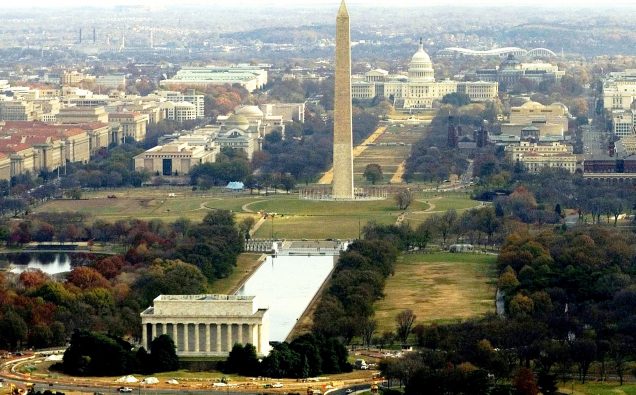
National Mall in Washington D.C. Photo by Chief Photographer’s Mate Johnny Bivera; cropped by Beyond My Ken (talk) 18:19, 2 May 2014 (UTC) [Public domain], via Wikimedia Commons
President Donald Trump on Monday signed an executive order to withdraw the United States from proposed Trans-Pacific Trade Agreement, advanced by his predecessor Barack Obama.
The move signals Trump’s intent to implement his campaign promises on international trade, which focuses on putting American workers’s interests at the heart of any trade deals.
The TPP, which had not been ratified by US Congress, aimed at forging trade and investment relations among 12 countries including the United States but 11 Pacific Rim nations.
Signed after years of negotiations, the agreement did not include China, and was interpreted to be a major initiative to expand American influence in the region, where a number of countries in South China Sea have territorial disputes with Beijing.
China has launched its own major initiatives like One Belt One Road to cement its trade ties across regions and with it expand its political influence as it grows in economic stature.
Besides United States, the countries that signed up to be part of the trade deal included Australia, Brunei Darussalam, Canada, Chile, Malaysia, Mexico, New Zealand, Peru, Singapore, Vietnam and Japan.
Meanwhile, President Trump has pledged to put America first in negotiating anFor too long,
A policy statement posted on the White House website says Americans have been forced to accept trade deals that put the interests of insiders and the Washington elite over the hard-working men and women of this country.
“As a result, blue-collar towns and cities have watched their factories close and good-paying jobs move overseas, while Americans face a mounting trade deficit and a devastated manufacturing base.”
The White House says “with a lifetime of negotiating experience, the President understands how critical it is to put American workers and businesses first when it comes to trade. With tough and fair agreements, international trade can be used to grow our economy, return millions of jobs to America’s shores, and revitalize our nation’s suffering communities.”
“This strategy starts by withdrawing from the Trans-Pacific Partnership and making certain that any new trade deals are in the interests of American workers,” the statement adds.
According to the policy statement, President Trump is also committed to renegotiating NAFTA (North American Free Trade Agreement) – a major trade deal engaging neighbors Canada and Mexico.
“If our partners refuse a renegotiation that gives American workers a fair deal, then the President will give notice of the United States’ intent to withdraw from NAFTA.y trade deals,” the statement says.















